A popular meme format at the moment is to juxtapose two pictures with the caption ‘How it started / How it’s going’. The first image shows the pride, and the second shows the fall. It’s a modern format for an extremely ancient narrative arc: hubris and nemesis. On the night of 6 January 2021, a version of this meme circulated online with two images of the west front of the United States Capitol in Washington, D.C. The first showed it in sunshine, decked with red, white and blue banners for a presidential inauguration, and looking spruce. The second showed it as it appeared that evening, in the twilight, wreathed in smoke, its terraces overrun with belligerent crowds, its balustrades ragged with partisan flags. Against the gloaming, an orange glow can be seen within the Capitol dome – just the building’s normal lighting, normally one of its more appealing features, suggestive of a lantern or beacon for democracy; but in the smoke, amid the obvious anger and chaos, it took on the complexion of arson.
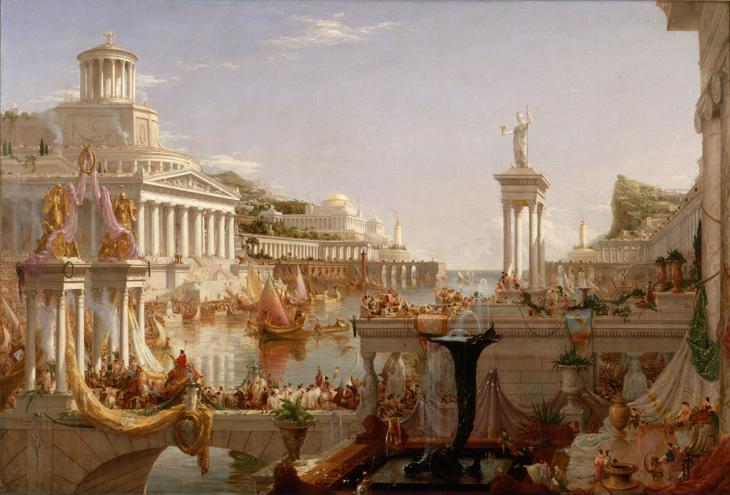
The Course of Empire: The Consummation of Empire (1835–36), Thomas Cole. New-York Historical Society (photo: Wikimedia Commons)
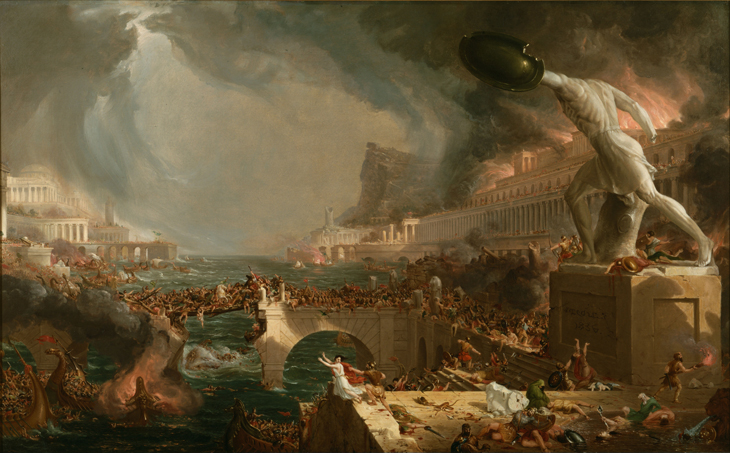
The Course of Empire: Destruction (1836), Thomas Cole. New-York Historical Society (photo: Wikimedia Commons)
An earlier version of the meme exists in art. The Course of Empire is a sequence of five large allegorical landscapes painted by Thomas Cole between 1833 and 1836. It depicts a classical empire rising from savagery to glory, followed by calamity and ruin. Consummation, the third painting in the series, shows the empire at its apogee, with a splendid marble capital in the midst of a festival; the fourth painting, Destruction, repeats the scene, but now the city is overrun and aflame, and the crowds thronging its terraces and bridges are barbarian invaders and their victims. Cole intended the sequence to have a moral message for the still-young American republic. The United States was moving, as he saw it, from the pastoral simplicity of the second painting to the imperial majesty of the third; if it was not careful, it would invite the fourth.
Even if you don’t know the paintings, the scenes on 6 January as supporters of President Trump stormed their way into the Capitol prompted many to follow Cole’s gloomy train of thought. Many pictures from the invasion seem destined to follow us for years to come: a Confederate flag carried through the inner sanctum of the Union; a cheerful, bearded man in a woolly hat waving to the camera as he carries away a lectern; a young man with glasses, dressed in animal skins and carrying a plastic riot shield, sat on a bench and staring into space as if overcome by events, like a full-grown version of a character at the end of Lord of the Flies; a horned, face-painted, bare-chested ‘shaman’ doing a strong-arm pose from the speaker’s podium in a hurriedly evacuated Senate chamber. As has often been the case during Trump’s five years at the centre of American politics, the outer appearance of comical chaos obscured a core of ugly purpose, as the protesters sought to derail the bureaucratic affirmation of Joe Biden as the 46th president, or even do violence to members of the American government.
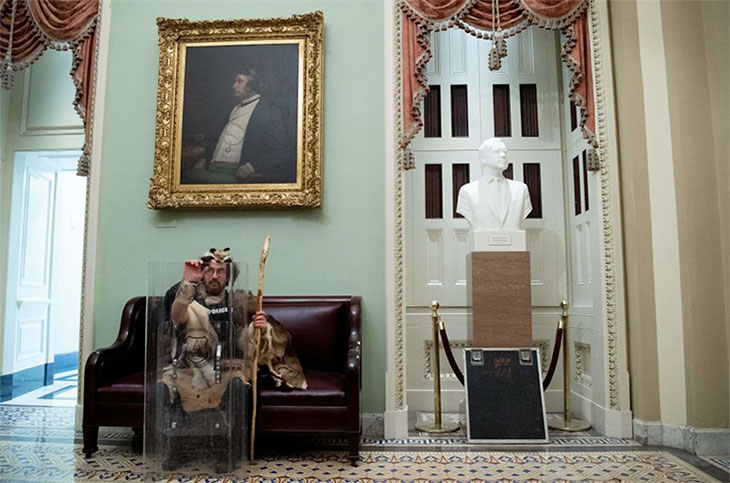
Inside the US Capitol on 6 January 2021. Photo: Saul Loeb/AFP via Getty Images
As events progressed, strange background details of the building – such as the intricate folds, pelmets, tassels and tiebacks of its ornamental drapery – drew the eye, as if the weirdness of the intruders brought out the weirdness of the building they had violated. That isn’t to denigrate the Capitol, but merely to note that legislatures and parliaments are often strange, hybrid places. They have basic functions as conference halls and office buildings, but also elevated ritual and symbolic functions as the factories of authority and legitimacy. Looking at the Capitol, we’re not just looking at a building, but also a collection of ideas.
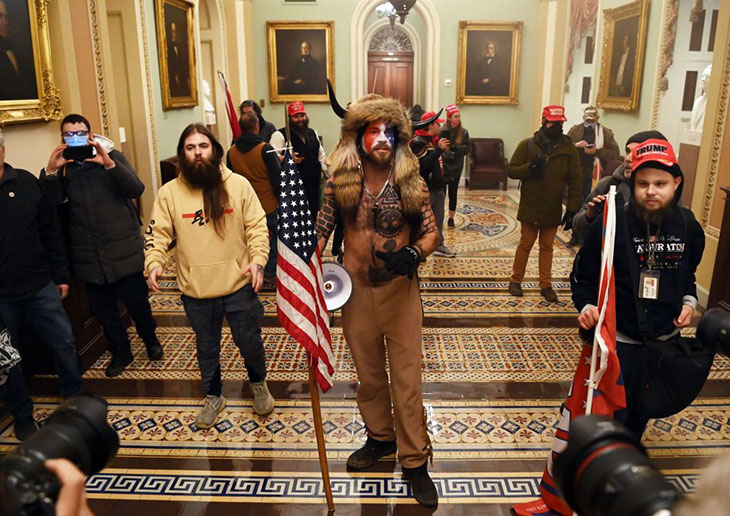
Rioters in the US Capitol on 6 January 2021. Photo: Saul Loeb/AFP via Getty Images
In the December days between his loss of the election and the violence at the Capitol, Trump signed an executive order ‘on Promoting Beautiful Federal Civic Architecture’, an effort to enshrine neoclassicism (and a few other ‘traditional’ styles) as the official architecture of the federal government, in the process proscribing modernism. The text of this order cites a list of buildings including the Capitol as ‘iconic symbols of our system of government’ and ‘cherished landmarks’. That’s indisputable – but is the Capitol ‘beautiful’? Those who cherish it for what it represents would call it that, but reverence has a way of eclipsing buildings from sight. The Capitol is such a symbol that it’s actually hard to look at it coolly, as a building. By showing the Capitol in a disturbing new context, the January riot momentarily revealed it.
The real advantage of civic neoclassicism isn’t that it’s automatically ‘beautiful’. It can be, but contrary to what architectural dirigistes on both sides of the Atlantic believe, beauty is highly subjective and impossible to legislate for. No, the advantage is that it looks the part, meeting various fairly conservative expectations of what a government building should look like. That was already true before the United States Capitol was built, and is why it was built in the neoclassical style to begin with. Today the Capitol, and the rest of Washington’s monumental core, is the example that sets the expectation, as spelled out in the executive order. That’s the way authority works, it rolls downhill, reinforcing itself as it goes, like a marmoreal snowball. This is demonstrated in the inverse by the UK: had the Palace of Westminster been built in a classical style rather than Barry and Pugin’s gothic (as was almost the case), we might have had the same civic neoclassical tradition here; it wasn’t, and we don’t.
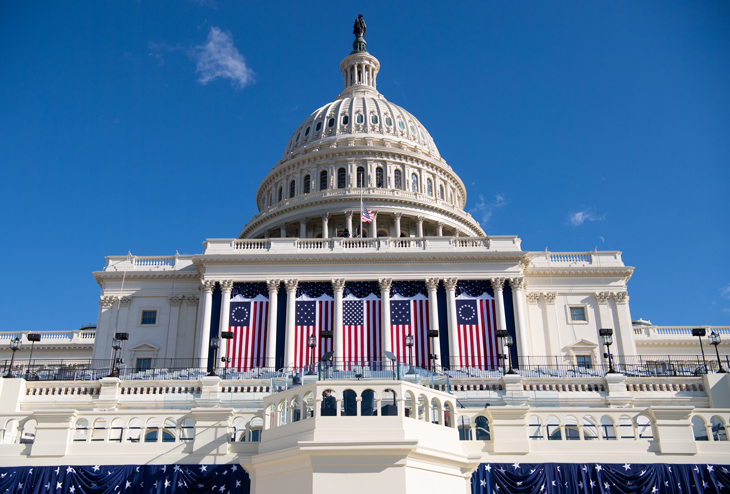
Dome laden: a view of the US Capitol in Washington, D.C., on 19 January – setting the stage for the presidential inauguration the following day. Photo: Saul Loeb/Getty Images
What neoclassicism also has going for it – besides its Age of Enlightenment associations – is ease of reproduction. Which isn’t to say that neoclassical buildings all look the same, even if a lot of them do, but amid the homogeneity imposed by the pattern book, it’s rewarding to look at what makes the Capitol distinctive and recognisable. The answer is very simple: its cast-iron dome, designed by Thomas Ustick Walter and completed in 1866, with its thicket of columns around the peristyle and vaguely fungal ridges and openings in the gloss-white cupola. Bring up a picture of the Capitol on your screen – one that isn’t just a picture of the dome – and block out the dome with your hand. The recognition largely drains from the image, leaving behind a grand but somewhat undistinguished frontage.
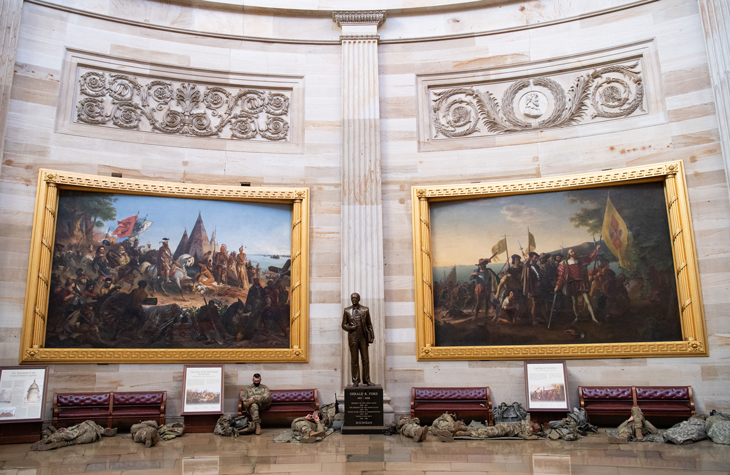
Members of the National Guard resting in the Capitol Rotunda on 13 January 2021, before the House vote to impeach President Trump for a second time. Photo: Saul Loeb/AFP via Getty Images
The Capitol has another feature of particular distinction, important to our conception of the whole: the sequence of steps and terraces at its west front, punctuated with a neat arcade of rounded arches – an entrance to the vast underground complex of crypts and tunnels and subways of which the visible portion of the building is only the summit, like the tip of a steampunk iceberg. The sight of a new president taking the oath of office against this backdrop is so familiar as to feel immemorial – but, in fact, the location has been used only since 1981. Today, assuming nothing more goes horribly awry, Joe Biden will become president there. But the affair will lack much of its usual swagger. The pandemic already meant that Biden’s inauguration was going to be a reduced affair. Only 1,000 tickets have been issued, as opposed to the usual 200,000, and the president-elect’s team has asked that the public stay away. Thanks to the 6 January riot, it now takes place in an atmosphere of intense security. The core of Washington, D.C. has become a fortified camp patrolled by 25,000 national guard troops. Roads, Metro stations and the National Mall are closed and barricaded. The ugly images of the Trumpists swarming the building have given way to similarly unnerving images of soldiers camped in the Capitol rotunda, the splendid space under the dome.

The invasion of the Capitol fulfilled a warning from history – and will haunt us for years to come
Selfie harm: rioters in the US Capitol rotunda on January 2021. Photo: Saul Loeb/AFP via Getty Images
Share
A popular meme format at the moment is to juxtapose two pictures with the caption ‘How it started / How it’s going’. The first image shows the pride, and the second shows the fall. It’s a modern format for an extremely ancient narrative arc: hubris and nemesis. On the night of 6 January 2021, a version of this meme circulated online with two images of the west front of the United States Capitol in Washington, D.C. The first showed it in sunshine, decked with red, white and blue banners for a presidential inauguration, and looking spruce. The second showed it as it appeared that evening, in the twilight, wreathed in smoke, its terraces overrun with belligerent crowds, its balustrades ragged with partisan flags. Against the gloaming, an orange glow can be seen within the Capitol dome – just the building’s normal lighting, normally one of its more appealing features, suggestive of a lantern or beacon for democracy; but in the smoke, amid the obvious anger and chaos, it took on the complexion of arson.
The Course of Empire: The Consummation of Empire (1835–36), Thomas Cole. New-York Historical Society (photo: Wikimedia Commons)
The Course of Empire: Destruction (1836), Thomas Cole. New-York Historical Society (photo: Wikimedia Commons)
An earlier version of the meme exists in art. The Course of Empire is a sequence of five large allegorical landscapes painted by Thomas Cole between 1833 and 1836. It depicts a classical empire rising from savagery to glory, followed by calamity and ruin. Consummation, the third painting in the series, shows the empire at its apogee, with a splendid marble capital in the midst of a festival; the fourth painting, Destruction, repeats the scene, but now the city is overrun and aflame, and the crowds thronging its terraces and bridges are barbarian invaders and their victims. Cole intended the sequence to have a moral message for the still-young American republic. The United States was moving, as he saw it, from the pastoral simplicity of the second painting to the imperial majesty of the third; if it was not careful, it would invite the fourth.
Even if you don’t know the paintings, the scenes on 6 January as supporters of President Trump stormed their way into the Capitol prompted many to follow Cole’s gloomy train of thought. Many pictures from the invasion seem destined to follow us for years to come: a Confederate flag carried through the inner sanctum of the Union; a cheerful, bearded man in a woolly hat waving to the camera as he carries away a lectern; a young man with glasses, dressed in animal skins and carrying a plastic riot shield, sat on a bench and staring into space as if overcome by events, like a full-grown version of a character at the end of Lord of the Flies; a horned, face-painted, bare-chested ‘shaman’ doing a strong-arm pose from the speaker’s podium in a hurriedly evacuated Senate chamber. As has often been the case during Trump’s five years at the centre of American politics, the outer appearance of comical chaos obscured a core of ugly purpose, as the protesters sought to derail the bureaucratic affirmation of Joe Biden as the 46th president, or even do violence to members of the American government.
Inside the US Capitol on 6 January 2021. Photo: Saul Loeb/AFP via Getty Images
As events progressed, strange background details of the building – such as the intricate folds, pelmets, tassels and tiebacks of its ornamental drapery – drew the eye, as if the weirdness of the intruders brought out the weirdness of the building they had violated. That isn’t to denigrate the Capitol, but merely to note that legislatures and parliaments are often strange, hybrid places. They have basic functions as conference halls and office buildings, but also elevated ritual and symbolic functions as the factories of authority and legitimacy. Looking at the Capitol, we’re not just looking at a building, but also a collection of ideas.
Rioters in the US Capitol on 6 January 2021. Photo: Saul Loeb/AFP via Getty Images
In the December days between his loss of the election and the violence at the Capitol, Trump signed an executive order ‘on Promoting Beautiful Federal Civic Architecture’, an effort to enshrine neoclassicism (and a few other ‘traditional’ styles) as the official architecture of the federal government, in the process proscribing modernism. The text of this order cites a list of buildings including the Capitol as ‘iconic symbols of our system of government’ and ‘cherished landmarks’. That’s indisputable – but is the Capitol ‘beautiful’? Those who cherish it for what it represents would call it that, but reverence has a way of eclipsing buildings from sight. The Capitol is such a symbol that it’s actually hard to look at it coolly, as a building. By showing the Capitol in a disturbing new context, the January riot momentarily revealed it.
The real advantage of civic neoclassicism isn’t that it’s automatically ‘beautiful’. It can be, but contrary to what architectural dirigistes on both sides of the Atlantic believe, beauty is highly subjective and impossible to legislate for. No, the advantage is that it looks the part, meeting various fairly conservative expectations of what a government building should look like. That was already true before the United States Capitol was built, and is why it was built in the neoclassical style to begin with. Today the Capitol, and the rest of Washington’s monumental core, is the example that sets the expectation, as spelled out in the executive order. That’s the way authority works, it rolls downhill, reinforcing itself as it goes, like a marmoreal snowball. This is demonstrated in the inverse by the UK: had the Palace of Westminster been built in a classical style rather than Barry and Pugin’s gothic (as was almost the case), we might have had the same civic neoclassical tradition here; it wasn’t, and we don’t.
Dome laden: a view of the US Capitol in Washington, D.C., on 19 January – setting the stage for the presidential inauguration the following day. Photo: Saul Loeb/Getty Images
What neoclassicism also has going for it – besides its Age of Enlightenment associations – is ease of reproduction. Which isn’t to say that neoclassical buildings all look the same, even if a lot of them do, but amid the homogeneity imposed by the pattern book, it’s rewarding to look at what makes the Capitol distinctive and recognisable. The answer is very simple: its cast-iron dome, designed by Thomas Ustick Walter and completed in 1866, with its thicket of columns around the peristyle and vaguely fungal ridges and openings in the gloss-white cupola. Bring up a picture of the Capitol on your screen – one that isn’t just a picture of the dome – and block out the dome with your hand. The recognition largely drains from the image, leaving behind a grand but somewhat undistinguished frontage.
Members of the National Guard resting in the Capitol Rotunda on 13 January 2021, before the House vote to impeach President Trump for a second time. Photo: Saul Loeb/AFP via Getty Images
The Capitol has another feature of particular distinction, important to our conception of the whole: the sequence of steps and terraces at its west front, punctuated with a neat arcade of rounded arches – an entrance to the vast underground complex of crypts and tunnels and subways of which the visible portion of the building is only the summit, like the tip of a steampunk iceberg. The sight of a new president taking the oath of office against this backdrop is so familiar as to feel immemorial – but, in fact, the location has been used only since 1981. Today, assuming nothing more goes horribly awry, Joe Biden will become president there. But the affair will lack much of its usual swagger. The pandemic already meant that Biden’s inauguration was going to be a reduced affair. Only 1,000 tickets have been issued, as opposed to the usual 200,000, and the president-elect’s team has asked that the public stay away. Thanks to the 6 January riot, it now takes place in an atmosphere of intense security. The core of Washington, D.C. has become a fortified camp patrolled by 25,000 national guard troops. Roads, Metro stations and the National Mall are closed and barricaded. The ugly images of the Trumpists swarming the building have given way to similarly unnerving images of soldiers camped in the Capitol rotunda, the splendid space under the dome.
Unlimited access from just $16 every 3 months
Subscribe to get unlimited and exclusive access to the top art stories, interviews and exhibition reviews.
Share
Recommended for you
The good, the bad and the ugly – neoclassical architecture in modern times
It was the favoured architectural style of Stalin and the Nazis. What forms does classical revivalism take today?
Return to the source – the invention of American landscape painting
The painters of the Hudson River School are now firmly recognised as pioneers of American art – and inspiring a new generation of artists
The man who created ‘dictator chic’
Charles Percier may not be a household name, but his Empire style sums up the Napoleonic era – and has had imitators ever since